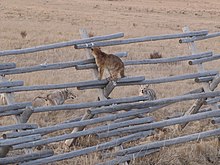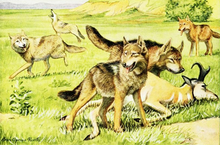User:Evancahill
Evancahill is a new Wikipedia user.
Message From Evancahill:
My main goal is currently to help expand info on Santa Barbara county.
Written on 8:47 a.m., Pacific Time, July 24, 2016
For a list of all of Evancahill's user pages, go here.



Featured Media Of The Day:
Evancahill says: I have to see one of these sometime.
For the featured picture and video, go down.
Background
Hi. :) I am a new Wikipedia user. I am male, and my activity on Wikipedia can vary from active to dormant, depending on my mood and my time. Currently, I am semi-active. I will expand this page as time goes on.
I'm mainly here to help with natural articles and some literature articles. I'm a content contributor for nature, and an article writer for literature. I started out enthusiastic when I learned you can edit. I almost immediately registered, and took the time to learn how to make articles and user pages. I am still new, but beginning to learn the way of things here.
I will not reveal too much personal info for the time being, but I'll tell you this: you can probably discover some possible personal info from what I write about. However, you'll never truly know. :)
I mainly just want to contribute to my interests and create some great articles. I also want to help the
I am proudly part of the Santa Barbara County Task Force. I am also part of one other task force, the Southern California Task Force, and two Wikiprojects, Wikiproject California and Wikiproject Star Wars.
Note: I occasionally edit without logging on.
Contributions
The Unwanteds(book)
My first creation was of a page about the book The Unwanteds form the The Unwanteds series. It is currently small and not-very-intersting, with only one verification and one individual section, with no subsections. I'd appreciate it if you could contribute to it.
Kellogg Elementary
My second creation is currently a failure. Its about an elementary school, and elementary schools aren't usually supposed to have individual pages about them. I will see whether I can manage to publish it.
For more, see the page User:Evancahill/contributions.
Interests
I love wildlife and computers! I especially like Fauna, even though Flora is also interesting.
And just because I like computers doesn't mean I write about them...I have more important stuff to do, like writing about more interesting stuff.: Actually False.
Status
I'm currently semi-active.
I Write About
Well, wildlife and nature, mainly, along with literature and occasionally schools. I'm especially interested in Southern California, in the northern-coastal section of the region. Geography, wildlife, books I've read...those all catch my eye.
I have made some edits to the Geography section of the page Goleta, California. I edited the Flora/Fauna sections(WILDLIFE!), and added info to the Architecture, Environment, and Ecology sections as well.
I've done some editing to Goleta, California, though. I also mean to promote the Santa Barbara County and Santa Barbara articles, along with the Channel Islands articles, as well.
Goals
- To get the Santa Barbara County task force up and running, again.
- To write about wildlife. Environment, Ecology, Geography, Flora, Fauna, Biodiversity, Geology, Climate, Wildlife...
- To finish up what's on my to-do list.
Video Of The Day
I love backyard wildlife! I keep thinking of the time I saw a coyote, so backyard wildlife + canine predator = this.
Picture Of The Day

I'm addicted to backyard wildlife, and I get both skunks and raccoons in my backyard. (Along with a hopelessly large amount of birds, bobcats, and foxes)
Stuff I'm Patrolling
Users
The IP address user: 68.70.40.70
An IP address for unregistered users from where I live
Pages
Extras







In areas where the ranges of coyotes and
Coyotes rarely kill healthy adult red foxes, and have been observed to feed or den alongside them, though they often kill foxes caught in traps. Coyotes may kill fox kits, but this is not a major source of mortality.[3] In southern California, coyotes frequently kill gray foxes, and these smaller canids tend to avoid areas with high coyote densities.[4]
Coyotes may compete with
In some areas, coyotes share their ranges with

Gray wolves typically dominate other
Brown bears typically dominate wolf packs in disputes over carcasses, while wolf packs mostly prevail against bears when defending their den sites. Both species kill each other's young. Wolves eat the brown bears they kill, while brown bears seem to only eat young wolves.[23] Wolf interactions with American black bears are much rarer than with brown bears, because of differences in habitat preferences. The majority of black bear encounters with wolves occur in the species' northern range, with no interactions being recorded in Mexico. Wolves have been recorded on numerous occasions to actively seek out black bears in their dens and kill them without eating them. Unlike brown bears, black bears frequently lose against wolves in disputes over kills.[24] While encounters with brown and black bears appear to be common, polar bears are rarely encountered by wolves, though there are two records of wolf packs killing polar bear cubs.[25] Wolves also kill the cubs of Asian black bears.[19]
Wolves may encounter striped hyenas in Israel, Central Asia and India, usually in disputes over carcasses. Striped hyenas feed extensively on wolf-killed carcasses in areas where the two species interact. One-to-one, hyenas dominate wolves, but wolf packs can drive off single or outnumbered hyenas.[26][27] However, there was a case of a female striped hyena dominating 12 Arabian wolves.[28]
Large wolf populations limit the numbers of small to medium-sized
Leftovers of wolf kills are sometimes scavenged by wolverines. Wolverines usually wait until the wolves are done feeding, but have been known to drive away wolves from kills. However, there have been confirmed reports of wolf packs killing wolverines.[35]
Other than humans,
- PMID 17922704.
- ^ a b Young & Jackson 1978, pp. 93–96
- JSTOR 1381437.
- ^ PMID 24595837.
- ISBN 0226353478
- doi:10.1139/z89-170.)
{{cite journal}}: CS1 maint: multiple names: authors list (link - ^ JSTOR 3784713.
- ^ Anderson, E. M. (1986). Bobcat behavioral ecology in relation to resource use in southeastern Colorado. Dissertation, Colorado State University, Fort Collins, USA.
- ^ Jackson, D. H. (1986). Ecology of bobcats in east-central Colorado. Dissertation, Colorado State University, Fort Collins, USA.
- ^ Toweill, D. E. (1986). Resource partitioning by bobcats and coyotes in a coniferous forest. Thesis, Oregon State University, Corvallis, USA
- ^ JSTOR 3672519.
- JSTOR 3830671.
- ^ doi:10.1002/wsb.59.
- ^ O’Donoghue, M.; Hofer, E. J.; Doyle, F. I. (1995). "Predator versus predator". Natural History. 104: 6–9.
- ISBN 111894755X.
- ^ Bushkirk, SW.; Ruggiero, LF.; and Krebs, CJ. (2000) Ch. 4 "Habitat Fragmentation and Interspecific Competition: Implications for Lynx Conservation", pp. 91–92 in L. F. Ruggiero, K. B. Aubry, S. W. Buskirk, G. M. Koehler, C. J. Krebs, K. S. McKelvey and J. R. Squires (eds.) Ecology and conservation of lynx in the United States]]. University Press of Colorado, Denver.
- ^ a b Mech & Boitani 2003, pp. 266–68
- ^ Robbins, Jim (1998). "Weaving A New Web: Wolves Change An Ecosystem". Smithsonian National Zoological Park. Archived from the original on January 24, 2009. Retrieved August 10, 2007.
- ^ a b c d e f Cite error: The named reference
heptner1998was invoked but never defined (see the help page). - ^ Giannatos G. (2004) Conservation Action Plan for the golden jackal Canis aureus L. in Greece. WWF Greece: 1–47
- ^ Mech & Boitani 2003, p. 269
- ^ Nair, M. V.; Panda, S. K. (2013). "Just Friends". Sanctuary Asia. XXXIII: 3.
- ^ Mech & Boitani 2003, pp. 261–63
- ^ Mech & Boitani 2003, pp. 263–64
- ^ "Wolf (Canis lupus) Predation of a Polar Bear (Ursus maritimus) Cub on the Sea Ice off Northwestern Banks Island, Northwest Territories, Canada" (PDF). Arctic. 59 (3): 322–324. 2006. Retrieved March 16, 2010.
- ISBN 978-2-8317-0442-5.)
{{cite book}}: CS1 maint: multiple names: authors list (link - ^ Nayak, S.; Shah, S.; Borah, J. (2015). "Going for the kill: an observation of wolf-hyaena interaction in Kailadevi Wildlife Sanctuary, Rajasthan, India". Canid Biology & Conservation. 18 (7): 27–29.
- ^ "BBC Two - Wild Arabia, The Jewel of Arabia, Wolves vs hyena". BBC.
- ^ Mech & Boitani 2003, pp. 264–65
- ^ Grooms, Steve (2010). "Cougar Wolf Interactions: It's a Lot Like Cats and Dogs". International Wolf. 20 (2): 8–11.
- ^ ISBN 90-04-08876-8
- ^ "Wolf". Snow Leopard Trust.
- ISBN 0-226-77999-8
- ^ "Yellowstone Wildlife – Wolverhampton Wanderers F.C." Yellowstone National Park.
- ^ "Gulo gulo" (PDF). American Society of Mammalogists.
- ^ Cite error: The named reference
WoTwas invoked but never defined (see the help page). - ^ Cite error: The named reference
l29was invoked but never defined (see the help page). - ^ Cite error: The named reference
Mech 2003 265was invoked but never defined (see the help page). - ISBN 1559630809.
User Boxes
 | This user is a member of WikiProject Star Wars. |
| This user is hopelessly addicted to editing Wikipedia. |
| This user is a member of WikiProject Mammals. |
WikiProject Animals. !Join now |
| This user was born and raised in California. |
| This user lives in or hails from the U.S. State of California. |
| This user is interested in the U.S. State of California. |
| This user participates in WikiProject California. |
| This user participates in WikiProject California. |
| This user participates in the Southern California task force. |
| SoCal | This user lives in, hails from or is associated with Southern California. |
| This user lives in the U.S. state of California. |
tagging pages for problems . |
| This user is a skeptic. |
| This user has completed a 5k. |
| This user supports recycling. |
| This user is against smoking. |
| This user tries to do the right thing. If he makes a mistake, please let him know. |
autoconfirmed rights on the English Wikipedia. (verify ) |
pro-choice.‡ |
| This user prefers Mozilla Firefox. |
religious. |
| This user believes that when you die, YOU DIE!!. |
| US | This user uses American English. |
| This user is a male. |
| This user is a member of WikiProject Wildfire |
Canon equipment |

